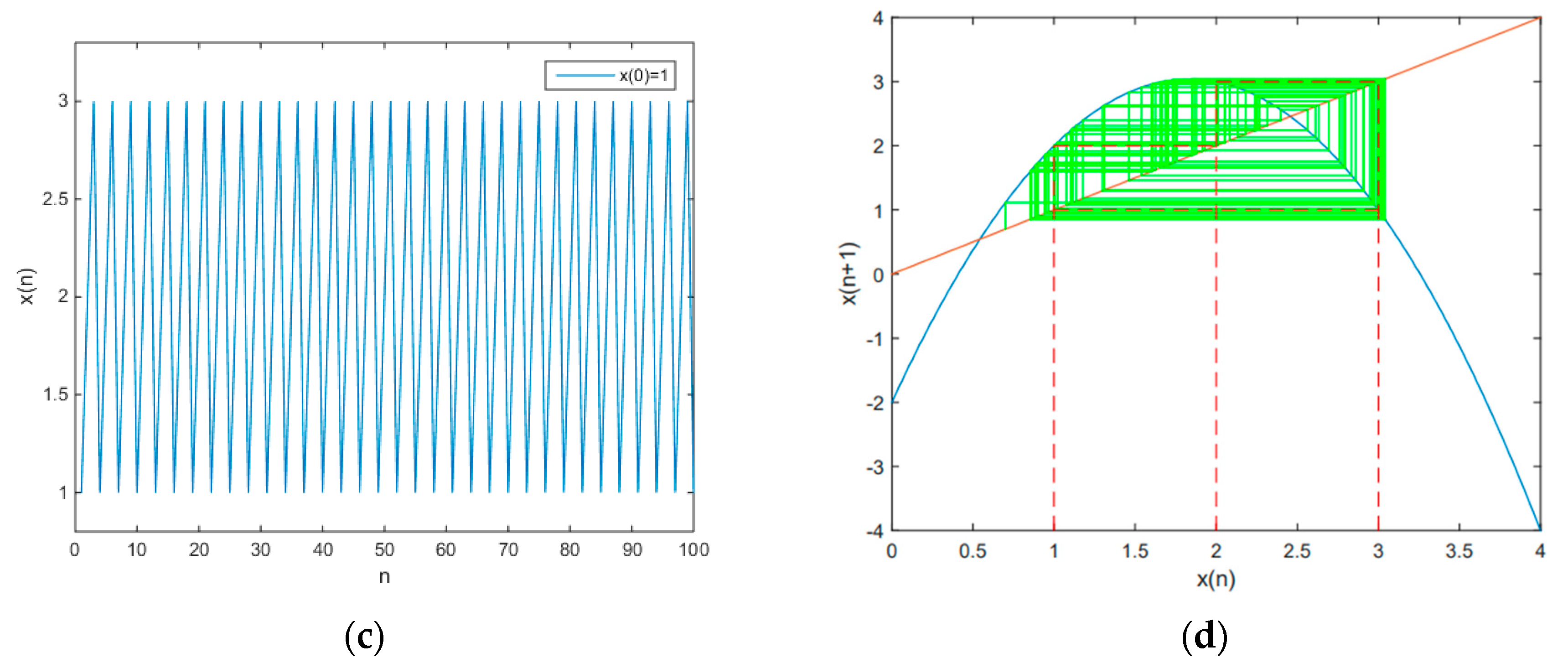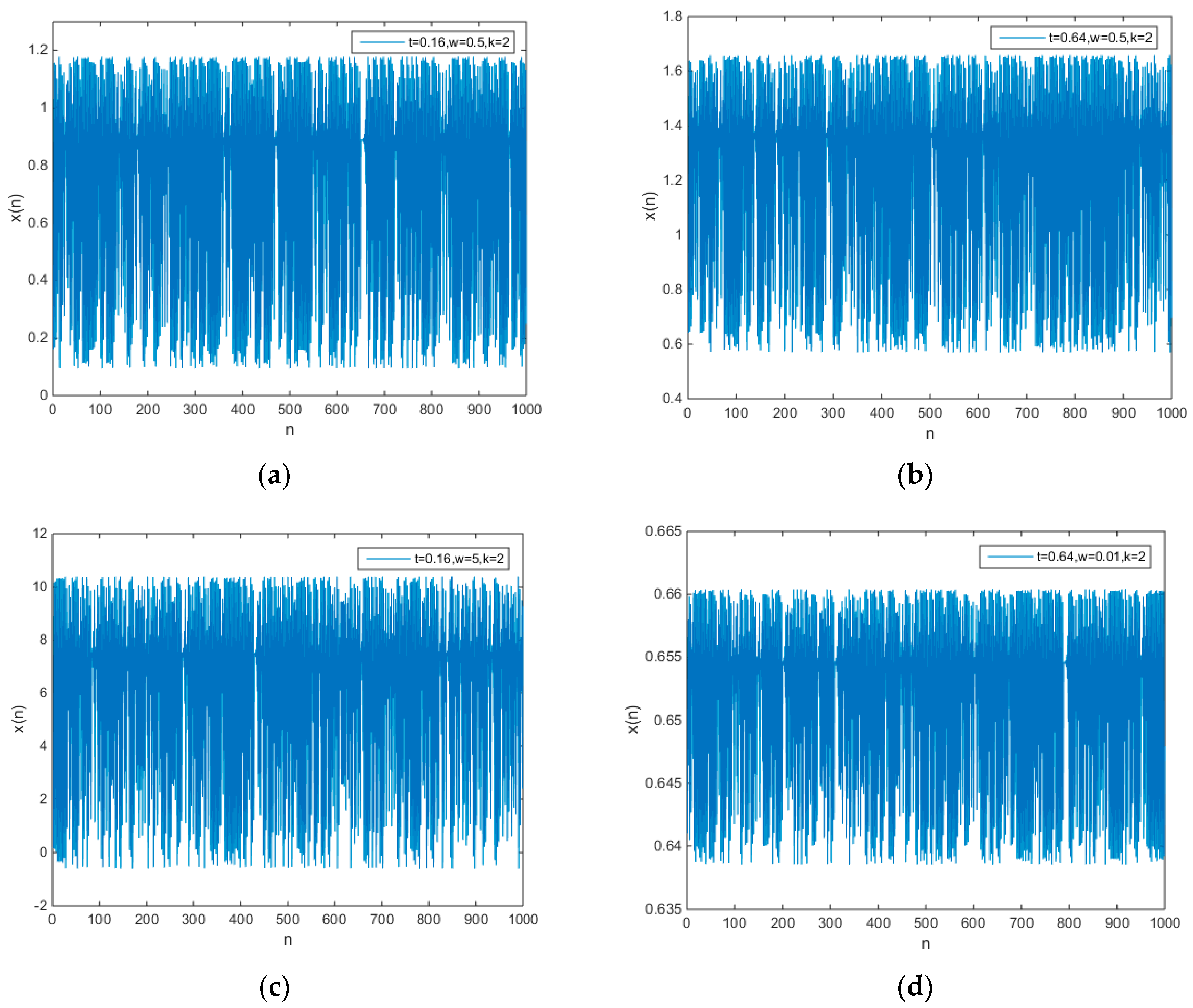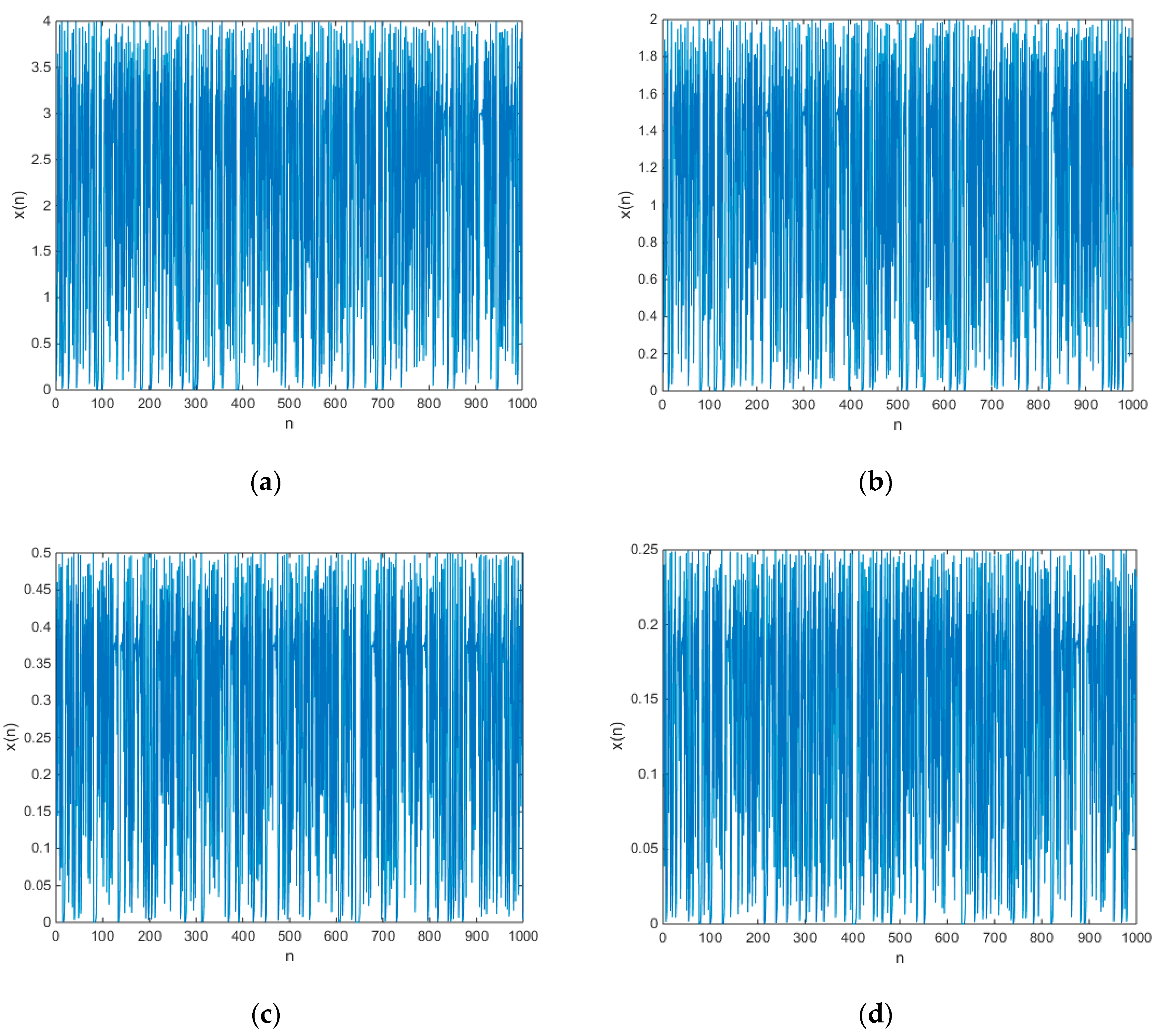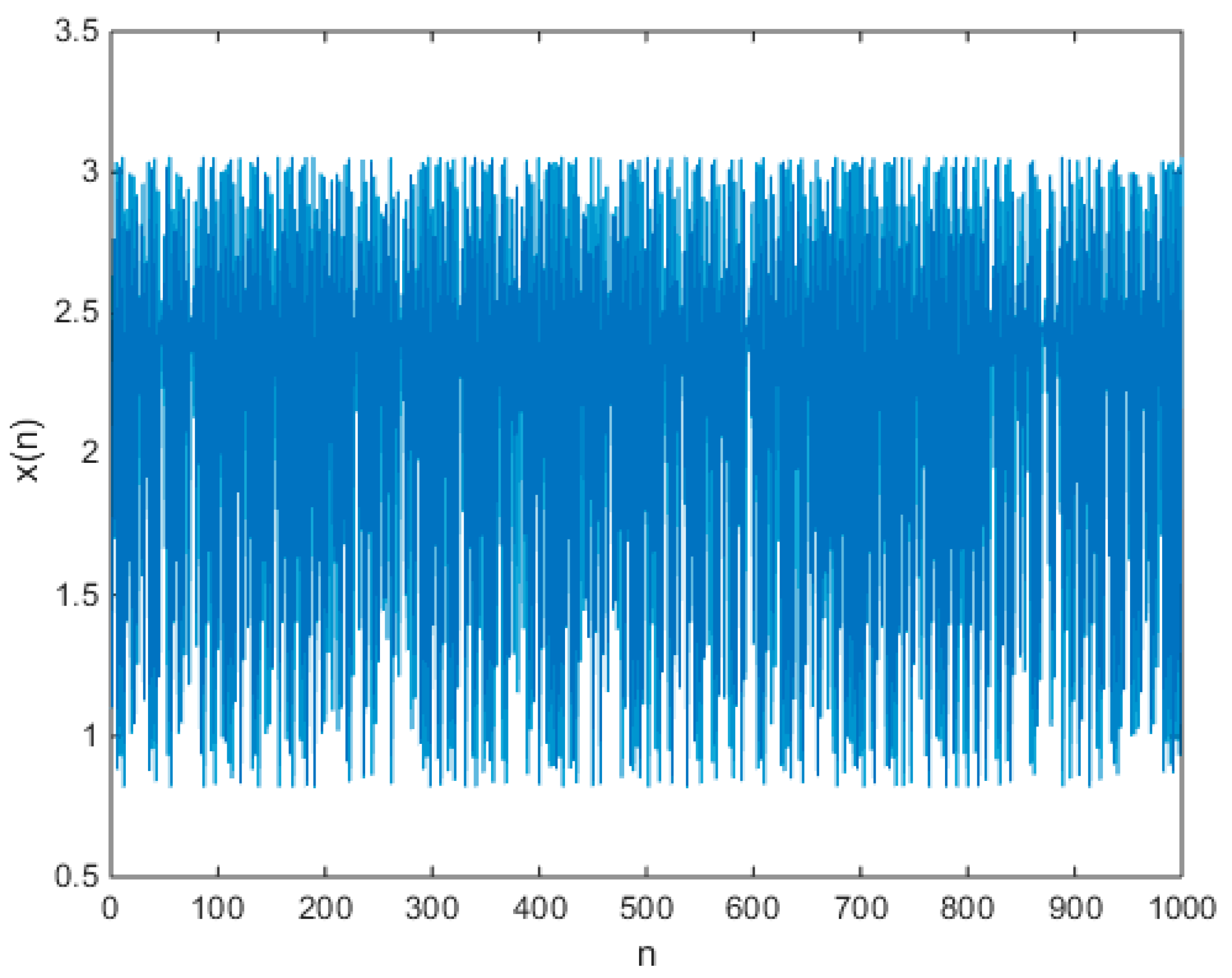A Class of Quadratic Polynomial Chaotic Maps and Their Fixed Points Analysis
Abstract
1. Introduction
2. The Mechanism of Constructing Quadratic Polynomial Chaotic Maps with Controllable Amplitude
2.1. Constructing Quadratic Polynomial Chaotic Maps
2.2. Fixed Points Analysis
2.2.1. Two Fixed Points
2.2.2. One Fixed Point
2.2.3. No Fixed Points
2.3. Amplitude Analysis
2.4. Concrete Scheme
3. Examples and Simulations
3.1. Constructing New Quadratic Polynomial Chaotic Maps
3.2. Amplitude Control
3.2.1. Amplitude Control of New Chaotic Maps
3.2.2. Amplitude Control of the Existing Chaotic Map
3.3. Approximate Entropy Analysis
- Suppose the initial data is the sequence , , …, and then divide them into -dimensional vectors:
- The distance between and is defined as:
- Setting a threshold value (), for each , we can obtain the statistics of :
- The mean of the logarithm of is written as and can be calculated by:
- Changing dimension and repeating step 1 to step 4, we can obtain the approximate entropy:
4. Constructions of High-Degree Polynomial Chaotic Maps
5. Conclusions
Author Contributions
Funding
Conflicts of Interest
References
- Sprott, J.C. Strange Attractors: Creating Patterns in Chaos; M&T Books: New York, NY, USA, 2000. [Google Scholar]
- Chen, G.; Lai, D. Feedback control of Lyapunov exponents for discrete-time dynamical systems. Int. J. Bifurc. Chaos 1996, 6, 1341–1349. [Google Scholar] [CrossRef]
- Chen, A.; Lu, J.; Yu, S. Generating hyperchaotic Lu attractor via state feedback control. Physica A 2006, 364, 103–110. [Google Scholar] [CrossRef]
- Lin, Z.; Yu, S.; Lü, J.; Cai, S.; Chen, G. Design and ARM-embedded implementation of a chaotic map-based real-time secure video communication system. IEEE. Trans. Circ. Syst. Vid. 2015, 25, 1203–1216. [Google Scholar]
- Wang, C.; Fan, C.; Feng, K.; Huang, X.; Ding, Q. Analysis of the time series generated by a new high-dimensional discrete chaotic system. Complexity 2018, 2018, 9818520. [Google Scholar] [CrossRef]
- Li, Y.; Chen, G.; Tang, W. Controlling a unified chaotic system to hyperchaotic. IEEE. Trans. Circuits-II 2005, 52, 204–207. [Google Scholar]
- Wang, C.; Fan, C.; Ding, Q. Constructing discrete chaotic systems with positive Lyapunov exponents. Int. J. Bifurc. Chaos 2018, 28, 1850084. [Google Scholar] [CrossRef]
- Kapitaniak, T.; Chua, L.; Zhong, G. Experimental hyperchaos in coupled Chua’s circuits. IEEE Trans. Circuits Syst.-I Fund. Th. Appl. 1994, 41, 499–503. [Google Scholar] [CrossRef]
- Cafagna, D.; Grassi, G. Hyperchaotic coupled Chua circuits: An approach for generating new nmscroll attractors. Int. J. Bifurc. Chaos 2003, 13, 2537–2550. [Google Scholar] [CrossRef]
- Li, Y.; Tang, W.; Chen, G. Hyperchaos evolved from the generalized Lorenz equation. Int. J. Circ. Theor. Appl. 2010, 33, 235–251. [Google Scholar] [CrossRef]
- Wang, X.; Wang, M. A hyperchaos generated from Lorenz system. Physica A 2008, 387, 3751–3758. [Google Scholar] [CrossRef]
- Jiang, H.B.; Liu, Y.; Wei, Z.; Zhang, L.P. Hidden chaotic attractors in a class of two-dimensional maps. Nonlinear Dyn. 2016, 85, 2719–2727. [Google Scholar] [CrossRef]
- Jiang, H.B.; Liu, Y.; Wei, Z.; Zhang, L.P. A New Class of Three-Dimensional Maps with Hidden Chaotic Dynamics. Int. J. Bifurc. Chaos 2016, 26, 1650206. [Google Scholar] [CrossRef]
- Jafari, S.; Pham, T.; Moghtadaei, M.; Kingni, S.T. The relationship between chaotic maps and some chaotic systems with hidden attractors. Int. J. Bifurc. Chaos 2016, 26, 1650211. [Google Scholar] [CrossRef]
- Wang, C.; Ding, Q. A new two-dimensional map with hidden attractors. Entropy 2018, 20, 322. [Google Scholar] [CrossRef]
- Li, T.Y.; Yorke, J.A. Period Three Implies Chaos. Am. Math. Mon. 1975, 82, 985–992. [Google Scholar] [CrossRef]
- Sharkovskii, A.N. Co-existence of cycles of a continuous mapping of the line into itself. Ukrainian Math. J. 1964, 16, 61. [Google Scholar]
- May, R.M. Simple mathematical models with very complicated dynamics. Nature 1976, 261, 459–467. [Google Scholar] [CrossRef] [PubMed]





| Chaotic Map | ApEn | |||
|---|---|---|---|---|
| (Equation (11)) | 2 | 0.1155 | 1000 | 0.4278 |
| (Equation (15a)) | 2 | 0.0578 | 1000 | 0.3904 |
| (Equation (15b)) | 2 | 0.0577 | 1000 | 0.3844 |
| (Equation (15c)) | 2 | 0.5649 | 1000 | 0.4650 |
| (Equation (15d)) | 2 | 0.0012 | 1000 | 0.4199 |
| (Equation (16)) | 2 | 0.0525 | 1000 | 0.6349 |
| (Equation (17a)) | 2 | 0.2113 | 1000 | 0.6401 |
| (Equation (17b)) | 2 | 0.1056 | 1000 | 0.6333 |
| (Equation (17c)) | 2 | 0.0262 | 1000 | 0.6353 |
| (Equation (17d)) | 2 | 0.0132 | 1000 | 0.6508 |
© 2019 by the authors. Licensee MDPI, Basel, Switzerland. This article is an open access article distributed under the terms and conditions of the Creative Commons Attribution (CC BY) license (http://creativecommons.org/licenses/by/4.0/).
Share and Cite
Wang, C.; Ding, Q. A Class of Quadratic Polynomial Chaotic Maps and Their Fixed Points Analysis. Entropy 2019, 21, 658. https://doi.org/10.3390/e21070658
Wang C, Ding Q. A Class of Quadratic Polynomial Chaotic Maps and Their Fixed Points Analysis. Entropy. 2019; 21(7):658. https://doi.org/10.3390/e21070658
Chicago/Turabian StyleWang, Chuanfu, and Qun Ding. 2019. "A Class of Quadratic Polynomial Chaotic Maps and Their Fixed Points Analysis" Entropy 21, no. 7: 658. https://doi.org/10.3390/e21070658
APA StyleWang, C., & Ding, Q. (2019). A Class of Quadratic Polynomial Chaotic Maps and Their Fixed Points Analysis. Entropy, 21(7), 658. https://doi.org/10.3390/e21070658




